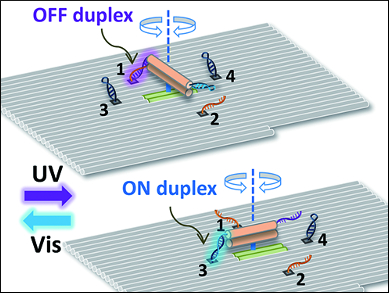Functional DNA nanostructures can be used for tasks ranging from cargo transport to logic functions. However, the development of functional DNA-based nanostructures is hampered by challenges concerning their regulation with specific stimuli. Recently, some advancement has been made in this field through the use of DNA strand-displacement reactions or the addition of metal ions or protein particles, which induce rotational movement. Such methods can lead to the need to remove byproducts at later stages because of the use of additives.
Masayuki Endo, Hiroshi Sugiyama, Kyoto University, Japan, and colleagues have developed a DNA-based molecular photoswitchable rotor with fully reversible function. The bar-shaped DNA rotor consists of a rigid molecular wire on a rectangular DNA tile. Two azobenzene-tethered oligonucleotides are used as photoresponsive receptors which are able to switch between cis and trans isomers with different irradiation wavelengths. These nucleotides were placed on the rotor and the tile separately and functioned as hooks and anchors to regulate the rotation of the rotor (pictured). The rotor has a length of approximately 20 nm.
The researchers used AFM imaging to follow the rotations on the tile. By changing between UV and visible light irradiation, the rotor could be switched between perpendicular and parallel states. A major advantage of this type of switching is that the wavelengths required have energies low enough not to damage the DNA significantly.
- A Photoregulated DNA-Based Rotary System and Direct Observation of Its Rotational Movement,
Yangyang Yang, Ryu Tashiro, Yuki Suzuki, Tomoko Emura, Kumi Hidaka, Hiroshi Sugiyama, Masayuki Endo,
Chem. Eur. J. 2017, 23, 3979–3985.
DOI: 10.1002/chem.201605616




